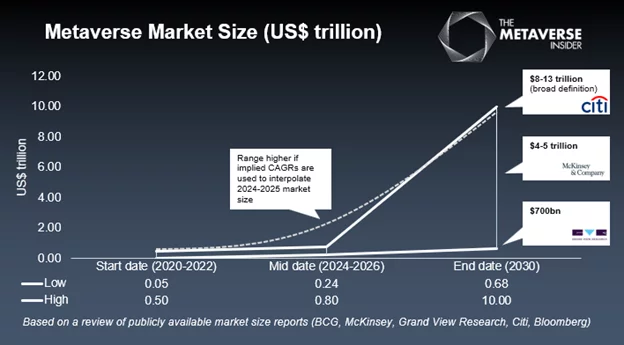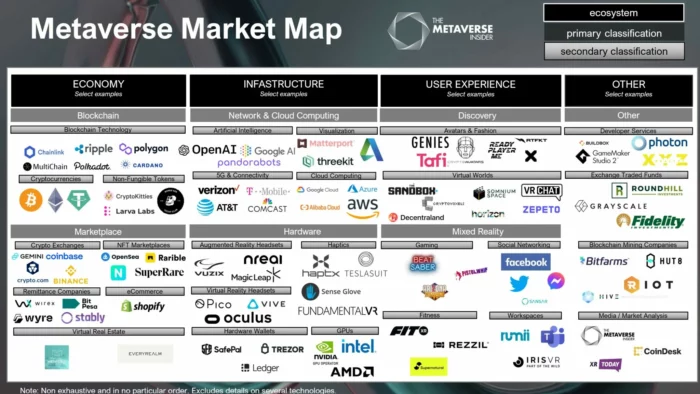Digital Twin Insider recently announced a report explaining the Metaverse Market Size. We believe the metaverse market size will be around 5.8 trillion by 2030. This industry is fast-emerging and very new. The potential of what the metaverse could become is often debated. We conducted thorough research on the Metaverse, and the sectors involved in enabling the metaverse. In this article, we explain our thorough process of calculating the USD 5.8 trillion market and the steps involved in identifying the sectors, list of assumptions, and predictions of this emerging industry.
Introduction:
Studying Precedent Market Reports
There have been many Metaverse Market Reports which have predicted the future market size of this fast-evolving industry. At Digital Twin Insider, we analyzed market size predictions for 2030. Some popular predictions and analyses we studied included McKinsey & Company, Citibank, and Grandview Research. While all these market size predictions predicted a promising future ahead for the Metaverse, the size of the market predictions varied greatly. In this article, we looked at the variations between different market sizes.


Dissecting the Metaverse Market Map
Predicting the market size of the metaverse is a challenging task, as there are many variables and assumptions that need to be made. As we studied different metaverse reports, it became increasingly clear that a thorough metaverse market map would allow us to identify the sectors that make up this emerging industry. Each sector has certain companies that are emerging as market leaders. However, as most analysts would agree, we are at an extremely early stage of the metaverse market system, and it is very hard to identify which companies will be market leaders in the future.

Understanding Key Enabling Technologies
At such an early stage of the metaverse market, where the industry is still emerging, it is difficult to identify the market leaders and their potential. Web2 tech giants have pivoted to the metaverse industry as companies like Meta and Microsoft look at many different sectors identified in the metaverse market map. Thus, to get a better understanding, we took another approach to sizing the market opportunity – we focused on the identifying the underlying technologies that will make up this metaverse industry. Rather than focusing on an ephemeral concept of the metaverse, we completed a deep dive on a set of several core technologies that are being developed simultaneously that will shape the internet and our future in the upcoming years.

Through triangulating our in-depth study, other forecasts and our key enabling technologies lens we refined the data to calculate a robust prediction of the metaverse market size and trajectory.
Market Size Calculations Methodology
In our calculations, we took 2 approaches, the top-down and the bottom-up approach:
Bottom-Up Approach:
Having gone through a detailed process of defining the market, which included studying external reports, sectors involved, and enabling technologies, we were able to draft the accurate markets of the Metaverse. These markets were divided into consumer and enterprise markets.
Here are the consumer markets we studied for the calculations.
- Gaming
- eCommerce
- Live Entertainment
- eLearning
- Health & Fitness
- Advertising
- Digital Assets
- Headsets
Narrowing down to the consumer markets mentioned above was a process which involved studying all sectors and technologies involved in the metaverse, which directly involves the customers. We were able to narrow down to the above 8 markets, which involve consumers. We ensured these markets don’t overlap and we don’t miss any key market sector.
Once we identified and clearly defined the key sectors mentioned above, we studied each market sector as a separate market. We started studying reports and analyses on each market and identified the current market size of these sectors. We studied their growth rates and were able to make educated predictions on each market’s growth till 2030.
While all consumer markets mentioned above have a role to play in the metaverse development, the full sector cannot be included in the market size. For example, in the health and fitness industry, boxing classes over an internet class cannot be included in the size calculations. However, if someone uses Supernatural, A VR fitness application, it should be included in our market size calculations. Thus, we were able to calculate the market size of the metaverse by decoding each market’s market size and calculating their penetration rate in the metaverse.
There are also many enterprise-based use cases of the Metaverse. Governments, Financial Institutions, and Securities and Investments Funds are examples of the prominent enterprise use cases of the metaverse. On the other hand, media and market analysts (e.g. Digital Twin Insider) are also examples of enterprise use cases of the metaverse. While these use cases, and many others, have a prominent role to play in the Metaverse, these markets significantly had to deconstruct. Like the markets mentioned above, they have a significant amount of overlap and even greater uncertainty than consumer markets. While the use cases of consumer markets are starting to become apparent, enterprise use cases are still in their infancy.
Top-Down Approach
With the bottom-up approach, we started dissecting each sector of the metaverse in-depth. This is an extensive process requiring research and analysis. However, with many assumptions to make about the metaverse, it is a challenge to say with surety what the market size will be. Thus, we tried the Top-down approach of calculating the market size as well. For this approach, we have taken the metaverse market as a percentage of the global economy. This involves obtaining the market size of the whole digital economy.
Currently, the digital economy is dominated by Web2 giants (many of which are pivoting towards the metaverse). Our research involved studying the current market landscape of the whole digital economy and how it will increase in the next 8 years. We genuinely believe as the reach of the internet grows, the digital economy will continue to rise in rural areas as it has in the urban areas in the past 2 decades. Moreover, we predict that tech giants which overtook many Web 1.0 companies to become market leaders in their industries will look to prevent the same from happening to them when the use of the core enabling technologies increases. Thus, we predict that not only the use of the internet and the digital economy will continue to rise, but the penetration of the metaverse in the digital economy will also increase too. This penetration will be facilitated by the tech giants like Meta, Microsoft, and Epic Games pivoting their product offerings and new start-ups emerging.
Conclusion
Having an in-depth analysis of the Top-down and Bottom-up approach, the Digital Twin Insider was able to produce a detailed breakdown of the Metaverse Market Size, which analyzes the growth of different sectors involved, the penetration rates, and the key drivers of the Metaverse.
If you want to understand and study our in-depth analysis of the Metaverse market report, please reach out to Wazarat Hussain at [email protected].
If you found this article to be informative, you can explore more current Digital Twin news here exclusives, interviews, and podcasts.













